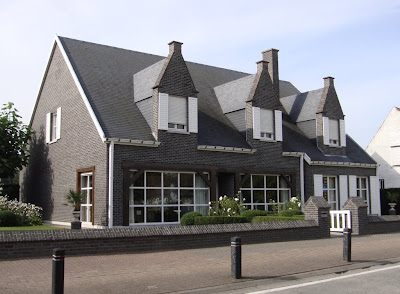
Whenever I travel to another country, I am always interested to see what the housing looks like. In Belgium, one finds streetscapes and housing types that are unique in the world...especially the medieval buildings in Bruges, Ghent, Brussels and Antwerp. But it is not just the older housing that is unique. Over the years, many different styles of housing have been built, often with a very creative use of brick. Even the newer homes offer something quite different.
In and around Zomergem where we were staying, there appeared to be a much greater interest in contemporary design compared to what I was used to in Canada. Almost all the new homes, regardless of their size, seemed to be designed by architects.
Above (top) is our neighbour Tomas and Martine's elegant, contemporay home, built right next door to a house with a thatch roof! I thought the other home was noteworthy for the manner in which it combined some historic elements in a contemporary home.
The new subdivisions were interesting both for the variety of architectural styles, but also the different forms of housing. In discussing this with Tomas, he told me that only in Belgium did one refer to this housing as open, half open and closed housing.
Open housing refers to detached housing, or as my British mother used to say 'homes standing on their own grounds'. Half open housing is what we would call semi-detached housing. However, unlike most North American semi-detached housing, each half is often designed by a different architect and built by a different owner. Closed housing is what we would call townhouses, or row housing. However again, each house could be designed by a different architect and built by a different owner. And each would be individually owned, not part of a condominium.
I found these ‘asymmetrical semis’ in Zomergem. While unusual, each half seemed quite sympathetic to the other, especially when compared with some of the other housing in the town, as evidenced below.

I was particularly impressed with this effort to combine the old with the new in Antwerp, while I am sure we might all have done it differently, it is a striking example of what is happening around many of the cities.

I wondered whether these semi-detached houses, often built on very large lots, might be developed in response to some special tax considerations. However, I was told that this was not the case. Rather, by not leaving side yards on both sides of the lot, one could build a larger home. (I need to check this out.)
The Belgiums are becoming increasingly concerned with environmental issues, although these two 'green homes' were perhaps motivated by something else...
In general, I was very intrigued with what I found. If I had to summarize Belgian design, I would have to say the housing in Belgium seems to be somewhat representative of the people, who are often non-conforming, individualistic and proud.




No comments:
Post a Comment